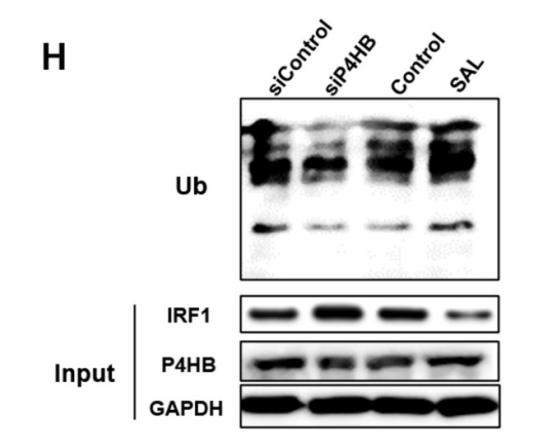Ubiquitin Antibody - #AF0289
| Product: | Ubiquitin Antibody |
| Catalog: | AF0289 |
| Description: | Rabbit polyclonal antibody to Ubiquitin |
| Application: | WB IHC IF/ICC |
| Cited expt.: | WB, IHC |
| Reactivity: | Human, Mouse, Rat |
| Prediction: | Pig, Zebrafish, Bovine, Horse, Sheep, Dog, Chicken, Xenopus |
| Mol.Wt.: | 8kDa; 15kD(Calculated). |
| Uniprot: | P62987 |
| RRID: | AB_2834166 |
Product Info
*The optimal dilutions should be determined by the end user. For optimal experimental results, antibody reuse is not recommended.
*Tips:
WB: For western blot detection of denatured protein samples. IHC: For immunohistochemical detection of paraffin sections (IHC-p) or frozen sections (IHC-f) of tissue samples. IF/ICC: For immunofluorescence detection of cell samples. ELISA(peptide): For ELISA detection of antigenic peptide.
Cite Format: Affinity Biosciences Cat# AF0289, RRID:AB_2834166.
Fold/Unfold
60S ribosomal protein L40; CEP52; HUBCEP52; L40; MGC126879; MGC57125; RPL40; UBA 52; Ubiquitin 52 amino acid fusion protein; Ubiquitin 60S ribosomal protein L40; Ubiquitin A 52 residue ribosomal protein fusion product 1; Ubiquitin carboxyl extension protein 52; Ubiquitin CEP52; UBA52;
Immunogens
A synthesized peptide derived from human UBA52, corresponding to a region within the internal amino acids.
- P62987 RL40_HUMAN:
- Protein BLAST With
- NCBI/
- ExPASy/
- Uniprot
MQIFVKTLTGKTITLEVEPSDTIENVKAKIQDKEGIPPDQQRLIFAGKQLEDGRTLSDYNIQKESTLHLVLRLRGGIIEPSLRQLAQKYNCDKMICRKCYARLHPRAVNCRKKKCGHTNNLRPKKKVK
Predictions
Score>80(red) has high confidence and is suggested to be used for WB detection. *The prediction model is mainly based on the alignment of immunogen sequences, the results are for reference only, not as the basis of quality assurance.
High(score>80) Medium(80>score>50) Low(score<50) No confidence
Research Backgrounds
Exists either covalently attached to another protein, or free (unanchored). When covalently bound, it is conjugated to target proteins via an isopeptide bond either as a monomer (monoubiquitin), a polymer linked via different Lys residues of the ubiquitin (polyubiquitin chains) or a linear polymer linked via the initiator Met of the ubiquitin (linear polyubiquitin chains). Polyubiquitin chains, when attached to a target protein, have different functions depending on the Lys residue of the ubiquitin that is linked: Lys-6-linked may be involved in DNA repair; Lys-11-linked is involved in ERAD (endoplasmic reticulum-associated degradation) and in cell-cycle regulation; Lys-29-linked is involved in lysosomal degradation; Lys-33-linked is involved in kinase modification; Lys-48-linked is involved in protein degradation via the proteasome; Lys-63-linked is involved in endocytosis, DNA-damage responses as well as in signaling processes leading to activation of the transcription factor NF-kappa-B. Linear polymer chains formed via attachment by the initiator Met lead to cell signaling. Ubiquitin is usually conjugated to Lys residues of target proteins, however, in rare cases, conjugation to Cys or Ser residues has been observed. When polyubiquitin is free (unanchored-polyubiquitin), it also has distinct roles, such as in activation of protein kinases, and in signaling.
Component of the 60S subunit of the ribosome. Ribosomal protein L40 is essential for translation of a subset of cellular transcripts, and especially for cap-dependent translation of vesicular stomatitis virus mRNAs.
Phosphorylated at Ser-65 by PINK1 during mitophagy. Phosphorylated ubiquitin specifically binds and activates parkin (PRKN), triggering mitophagy. Phosphorylation does not affect E1-mediated E2 charging of ubiquitin but affects discharging of E2 enzymes to form polyubiquitin chains. It also affects deubiquitination by deubiquitinase enzymes such as USP30.
Mono-ADP-ribosylated at the C-terminus by PARP9, a component of the PPAR9-DTX3L complex. ADP-ribosylation requires processing by E1 and E2 enzymes and prevents ubiquitin conjugation to substrates such as histones.
Cytoplasm. Nucleus.
Cytoplasm.
In the N-terminal section; belongs to the ubiquitin family.
In the C-terminal section; belongs to the eukaryotic ribosomal protein eL40 family.
Research Fields
· Genetic Information Processing > Translation > Ribosome.
References
Application: WB Species: human Sample: A375 cells
Application: IHC Species: human Sample: skin
Application: WB Species: Bovine Sample: BHK-21 cells
Restrictive clause
Affinity Biosciences tests all products strictly. Citations are provided as a resource for additional applications that have not been validated by Affinity Biosciences. Please choose the appropriate format for each application and consult Materials and Methods sections for additional details about the use of any product in these publications.
For Research Use Only.
Not for use in diagnostic or therapeutic procedures. Not for resale. Not for distribution without written consent. Affinity Biosciences will not be held responsible for patent infringement or other violations that may occur with the use of our products. Affinity Biosciences, Affinity Biosciences Logo and all other trademarks are the property of Affinity Biosciences LTD.







